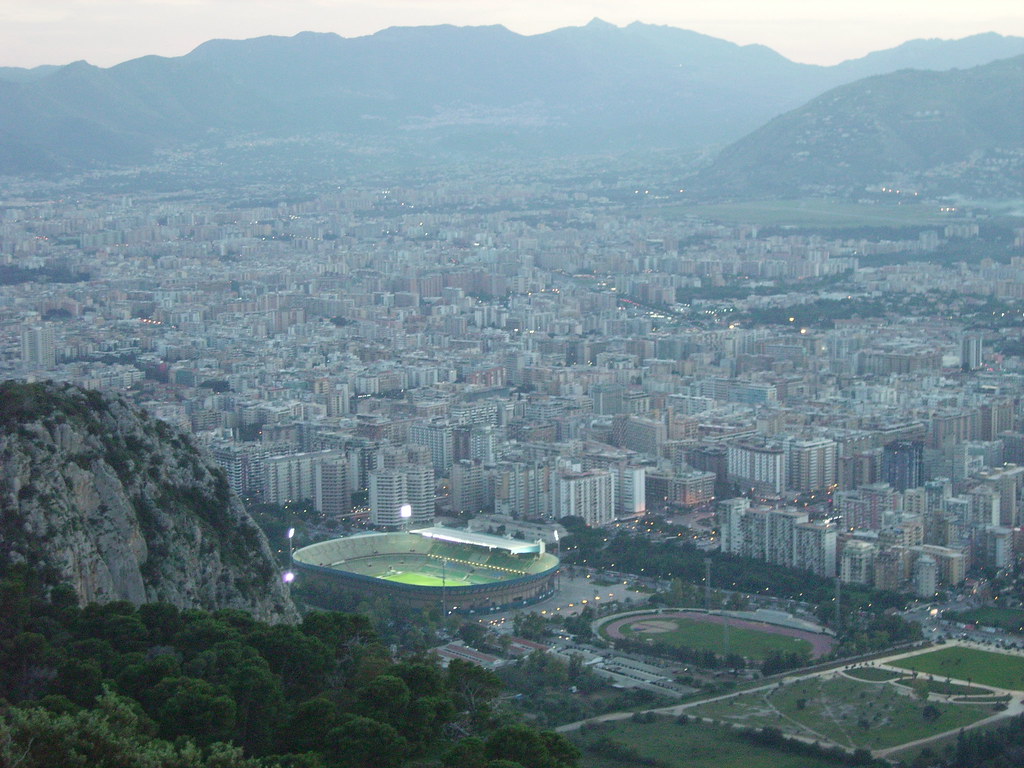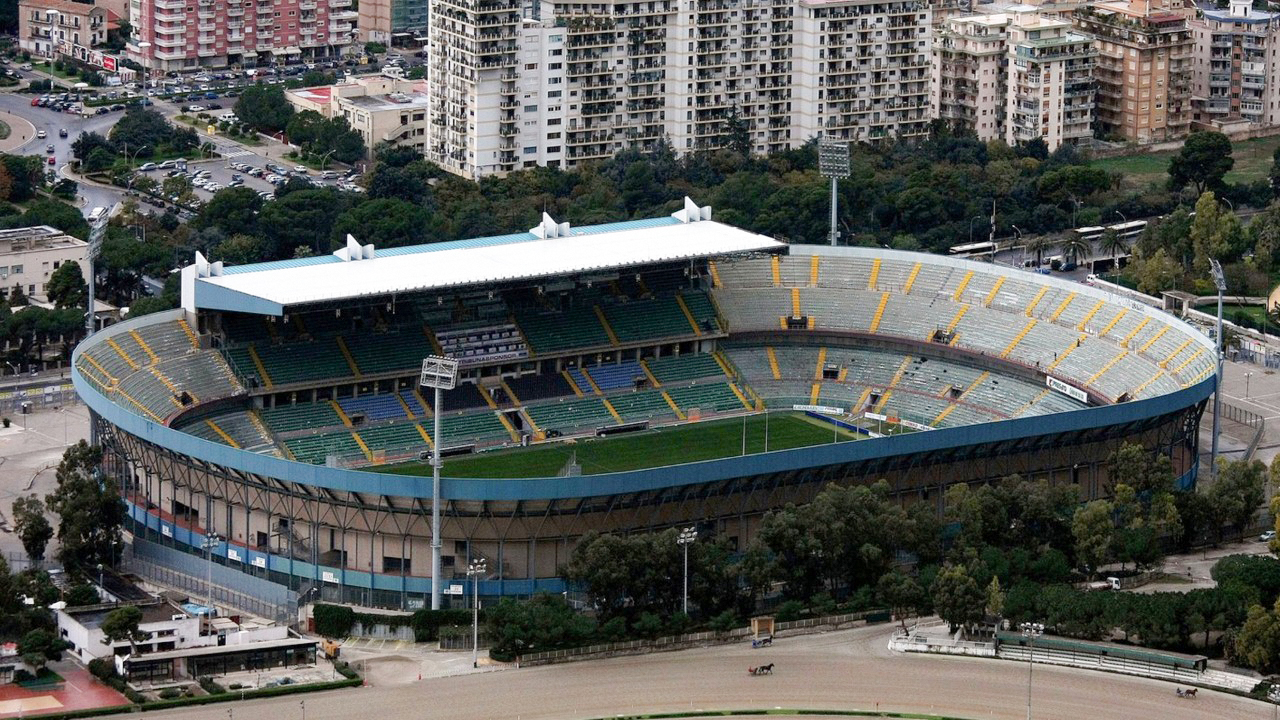Italy is often referred to as Lo Stivale (“the boot”) due to the boot-shaped silhouette of its peninsular territory. Using this as a basis for understanding where we’re going this week, let’s imagine Italy to be a right-foot boot. Well, today we’re heading towards the pinky toe of Italy.
Our trip is to the marvelous city of Palermo, the capital of the island of Sicily, where we find a stadium which, depending on who you ask, can be called in one way or another. Its official name is Stadio Renzo Barbera but, by most people, it is still known as La Favorita.
The stadium lies in the north of the city, next to the La Favorita Park (from which it borrows its name), very close to the city center and less than 5km from the Tyrrhenian Sea and the beautiful Vergine Maria beach. Do not expect to enjoy any sea view from the stands, however. It is quite the contrary, as the stadium is located at the foot of the Monte Pellegrino. The mountain still gives us a fantastic image of the playing ground from both the inside and the outside but covers the view of the beach.

The project for this stadium began in the early ‘30s. At that time, the city’s main team had been in existence for 30 years, half of them playing at a stadium known as Il Pantano (“the swamp” – a name quite descriptive itself) and the other half at the Stadio Ranchibile, whose only remarkable feature was that it had the regulatory goals.
It was in 1931 that the architect Giovan Battista Santangelo presented a project for a new stadium which, only a year later, would be inaugurated with the name Stadio Littorio (a very similar name to the future Renato Dall’Ara’s – evidently the originality of names was not the strongest point of the fascist regime).
It may be surprising to hear that it only took a year to build it, especially compared to other contemporary stadiums, but the structure was not very elaborated: It simply consisted of a pitch, an athletics track surrounding it, and two side stands. The inaugural match was played in January 1932 and resulted in a 5-1 landslide victory for the local Rosanero (“pink-and-black,” the colors of Palermo) against Atalanta. Both teams played in the Serie B at the time.
A few years later, in 1937, the name of the stadium was changed to Stadio Michele Marrone, in honor of a former Palermo player who had perished in the Spanish Civil War. In 1948, after World War II, the stadium changed its name again (but, hold on, we still have one more change coming…), officially becoming La Favorita, from the name of the park that still stands next to it today.
That same year, the first major remodeling was completed. The athletics track was removed, the stands were properly rebuilt to increase their capacity and give them a more professional football field look. When we say “properly,” that’s because the stands still had no seats or bleachers, and people used to simply gather in the adjacent esplanade to watch the games standing.
Let’s jump to 1982 – we are slowly approaching the turning point in the history of the Italian stadium renovations – when the South Stands had to be urgently remodeled due to a fire caused by some fans who were not very happy with Palermo’s results.
Two years later, the team placed a risky bet as they added an upper ring to the stands, increasing the stadium capacity by almost 80%. The problem was that the results did not follow, nor did the public. The Rosanero were swinging between the Serie B and the Serie C and there was only one occasion – a derby against cross-region rivals Messina – when La Favorita recorded a sold-out.

World Cup 1990 was a key event for the fate of the stadium. When the time came to choose which facilities would host the tournament matches, the organizing committee tried to spread them across the whole Italian territory. To cover the less economically-developed South, La Favorita was thus chosen to host some games despite being the smallest among the 11 venues selected. During the necessary renovation works, the stadium was closed and Palermo had to relocate to Trapani – losing both fan support and revenue.
There is an unfortunate tragedy linked to the remodeling of La Favorita. On August 30, 1989, two days after some FIFA delegates had come to Palermo to supervise the state of the works, part of the roof structure collapsed. Approximately eight tons of steel fell to the ground, echoing throughout the city and taking the lives of five workers.
A few days later, another part of the stadium gave way. There were no casualties this time, but the two incidents ignited criticism and speculations about the quality and state of the work. The materials used were said to be of poor quality because of corruption-related savings. The local administration, the mafia, the manpower, anyone who could be responsible was blamed at some point.
An investigation concluded that it was an anchoring error that made the structure unable to withstand the strong winds. Palermo was even questioned as a World Cup venue as there were doubts that renovations could be completed on time. The FIFA eventually resolved the stalemate by removing the obligation to roof part of the stadium, allowing works to resume just one week after the tragedy.
The remodeling was finished on time and the all-powerful Netherlands of Franklin Rijkaard, Ruud Gullit, and Marco Van Basten played their first World Cup 1990 match against Egypt in the renovated La Favorita.
Since then, little has changed in this venue. Palermo and their stadium peaked during the 2000s as they became a regular presence in the Serie A. In 2002, a new name change made the ground known as the Renzo Barbera in honor of the president who guided the club through the ‘70s between the Serie A and the Serie B and into two Coppa Italia Finals.
In 2005, Palermo reached their greatest sporting achievement as they qualified for the UEFA Cup – an exploit which prompted a new slight remodeling of their playing ground to meet the standard of the European competitions.
The Rosanero stood out for their keen eye for signing and discovering future stars. Over the last 20 years, the team has featured the likes of Edinson Cavani, Paulo Dybala, Andrea Barzagli, Salvatore Sirigu, Ezequiel Lavezzi, Josep Illic and probably one of the most remembered players in the recent history of the Nazionale: Fabio Grosso, who scored the penalty that gave Italy its last World Cup in 2006 while he was still playing for Palermo.
But, things have taken a bad turn for the Sicilians recently. After several up and down, and a painful refunding they had to go through in 2019, the club is currently playing in the Serie D – the fourth level of the Italian football pyramid.
Although recent, the good years this stadium has seen seem far away. There are fewer supporters in the Curva Nord (the North Stands) these days, but Palermo are still a historic team and one of the biggest in the South of Italy. If you stroll across Palermo, you can still catch a glimpse of the pride of a team that surprised everyone by qualifying for the UEFA Cup not long ago.
Perhaps, if you pay attention, you could even still hear the fans’ thunderous shout at Denis Godeas’ decisive qualification goal echoing from the Monte Pellegrino, on that day when the sky above the city, they say, was all pink and black.
Click Below to Visit Some More Temples of The Italian Football Cult:
The San Paolo Stadium in Napoli
The Luigi Ferraris aka Marassi
The Stadio Olimpico in Rome
The Renato Dall’Ara Stadium in Bologna
The San Nicola Stadium In Bari

